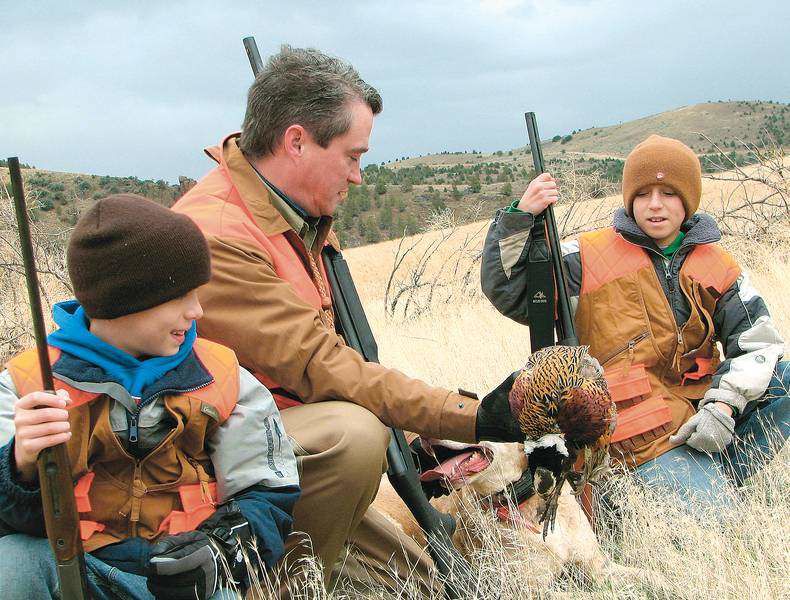Talkin’ turkey about pheasant
Published 5:00 am Thursday, October 18, 2007

- Jeff Aldrich, center, inspects a pheasant with Sam and Nolan King on a late-season pheasant hunt at Fisher's Gable Creek Ranch near Mitchell. An upcoming youth hunt is scheduled for Nov. 17 at Canyon Creek Shooting Preserve near Dufur.
An astonishing number of Americans will take a sedative this fall. It’ll happen in 45 million homes. Their narcotic of choice — tryptophan — comes labeled under the street names Bourbon Red, American Bronze, Royal Palm and Butterball. These are the most common vehicles for the delivery of the drug, but some users gather tryptophan in the wild – tagging Rio Grandes, Merriam’s, Gould’s, Osceolas and Easterns.
We’re talking turkey. Tryptophan is an essential amino acid found in poultry, fish, chocolate, oats and other good stuff. Taken in large quantity, with mashed potatoes, stuffing and pie, it can make you fall asleep during conversations with relatives. Not a bad thing.
Thanksgiving falls on Nov. 22 this year. If you want to bag your own gobbler, the general fall turkey season begins Oct. 15. But there’s another way. Start a new Thanksgiving tradition and go pheasant hunting.
I know what you’re thinking. It’s hard to go clean when the rest of the family is hooked on turkey, expecting turkey, salivating for turkey. It’s time for intervention. There’s no better way to change your future than with shotgun in hand and a dog at your side.
In Oregon, wild pheasant can be found in and around agricultural areas. Ontario, Nyssa, Vale, Boardman, Hermiston and Heppner are good bets. The Klamath Falls, Summer Lake and Lakeview areas are other options.
Oregon’s statewide pheasant hunt began Oct. 13 and will run through Dec. 9. In western Oregon, hunters can find birds on the E.E. Wilson wildlife area. Fee hunts and youth hunts are held in October. Consult the Oregon Game Bird Regulations for details.
Preserve hunting takes the place of past state-managed bird-planting operations. The system allows hunters to pursue upland birds through the end of March, far beyond the end of the public land season.
Some preserves plant birds early in the year, allowing their pheasants, chukars, and Hungarian partridge to take up residence, find mates, and raise broods of chicks. Other preserves turn out birds the day of the scheduled hunt.
It doesn’t take long for pen-raised roosters to gain some savvy once they’ve been released in good habitat. Often, birds from previous hunts will escape and may provide action or, more often, frustration for subsequent hunters.
Not all preserves are created equal. A few offer lodging and meals as part of the package. Almost all can provide a guide or a dog if you don’t bring your own. A few companies offer fishing and duck hunting, in season.
To find a preserve, check the classifieds section of this newspaper, find an ad in the 2007-2008 Oregon Game Bird Regulations, or ask for a recommendation at a sporting goods store.
One upcoming hunt in Central Oregon can provide a way for a youngster to bring home hard-earned birds for the holiday table.
The Bend Chapter of the Oregon Hunters Association (OHA) and the Oregon Department of Fish and Wildlife (ODFW) will host the fourth annual Youth Pheasant Hunt on Saturday, Nov. 17, at Canyon Creek Shooting Preserve near Dufur.
Young hunters (aged 10-17) must have completed an approved Hunter Education course and must have a hunting license and upland bird validation. Kids can bring their own hunting dogs (pointers are preferred), or can rely on the experienced dogs provided by volunteer guides. There will be a barbecue at the end of it all.
Sign-ups are underway for the free hunt. For more information, call the Bend ODFW office at 388-6363.
In case you’re wondering, there is tryptophan in pheasant. And there are seldom any leftovers.
This Thanksgiving, why not go “cold turkey” from domestic turkey? It may take time and effort to start down that road to recovery, but there’s no time like the present to start eating pheasant.






